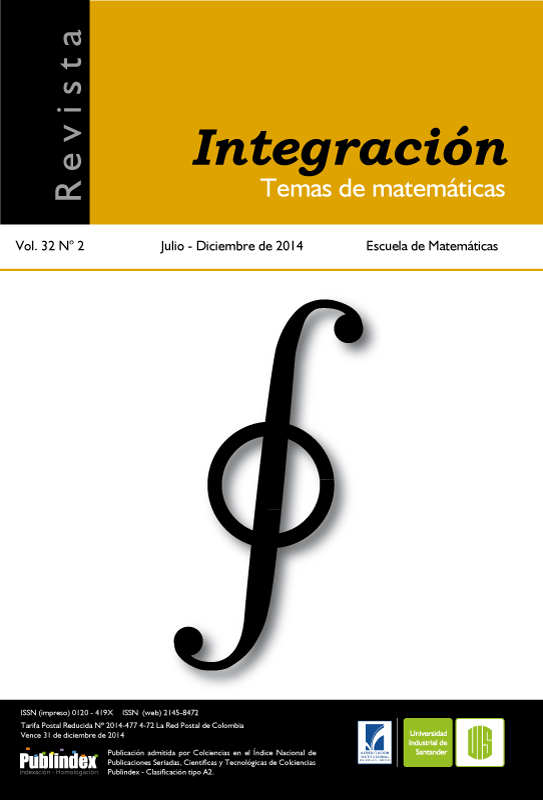Published 2014-10-31
Keywords
- Flipping edges in triangulations,
- convex decompositions,
- triangulations.
How to Cite
Abstract
Given a point set P on the plane, a convex decomposition of P is a set of convex polygons with vertices in P satisfying the following conditions: The union of all elements in is the convex hull of P, every element in is empty (that is, they no contain any element of P in its interior), and any given 2 elements in its interiors are disjoint intersecting them in at most one edge. It is known that if P has n elements, then there exists a convex decomposition of P with at most 7n/5 elements. In this work we give a procedure to find a specific convex decomposition of P with at most 3n/2 elements.
To cite this article: M. Lomelí-Haro, V. Borja, J.A. Hernández, Una descomposición convexa, Rev. Integr. Temas Mat. 32 (2014), no. 2, 169-180.
Downloads
References
- Aichholzer O. and Krasser H., “The point set order type data base: A collection of applications and results”, in Proc. 13th Canadian Conference on Computational Geometry, Waterloo, Ontario, Canada, (2001), 17-20.
- Boná M., A Walk Through Combinatorics. An Introduction to Enumeration and Graph Theory, World Scientific, 2006.
- Cormen T., Leiserson C.E., Rivest R.L. and Stein C., Introduction to Algorithms, McGrrawHill, Boston, 2001.
- Erdös P. and Szekeres G., “A combinatorial problem in geometry”, Compositio Math. 2 (1935), 463-470.
- García-López J. and Nicolás C., “Planar point sets with large minimum convex partitions”, in Proc. 22nd Euro. Workshop on Comput. Geom., Delphi, Greece, (2006), 51-54.
- Galtier J., Hurtado F., Noy M., Pérennes S. and Urrutia J., “Simultaneous Edge Flipping in Triangulations”, Internat. J. Comput. Geom. Appl. 13 (2003), no. 2, 113-133.
- Gerken T., “Empty convex hexagons in planar point sets”, Discrete Comput. Geom. 39 (2008), no. 1-3, 239-272.
- Harborth H., “Konvexe Fünfecke in ebenen Punktmengen”, Elem. Math. 33 (1978), no. 5, 116-118.
- Horton J.D., “Sets with no empty convex 7-gons”, Canad. Math. Bull. 26 (1983), no. 4, 482-484.
- Hosono K., “On convex decompositions of a planar point set”, Discrete Math. 309 (2009), no. 6, 1714-1717.
- Neumann V., Rivera-Campo E. and Urrutia J., “A note on convex decompositions of a setof points in the plane”, Graphs Combin. 20 (2004), no. 2, 223-231.
- Overmars M., Finding sets of points without empty convex 6-gons, Discrete Comput. Geom. 29 (2003), 153–158.
- Tóth G. and Valtr P., “Note on the Erdös-Szekeres theorem”, Discrete Comput. Geom. 19 (1998), no. 3, 457-459.
- Urrutia J., “Open-problem session”, in 10th Canadian Conference on Computational Geometry, Montreal, Canada, (1998).
